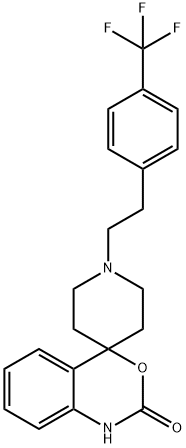300815-41-2
 300815-41-2 結(jié)構(gòu)式
300815-41-2 結(jié)構(gòu)式
基本信息
1'-(4-(三氟甲基)苯乙基)螺[苯并[D][1,3]惡嗪-4,4'-哌啶]-2(1H)-酮
1'-[2-[4-(三氟甲基)苯基]乙基]-螺[4H-3,1-苯并惡嗪-4,4'-哌啶]-2(1H)-酮
1'-[2-[4-(三氟甲基)苯基]乙基]-螺[4H-3,1-苯并惡嗪-4,4'-哌啶]-2(1H)-酮鹽酸鹽
1'-[2-[4-(三氟甲基)苯基]乙基]-螺[4H-3,1-苯并噁嗪-4,4'-哌啶]-2(1H)-酮鹽酸鹽
1'-(4-(trifluoromethyl)phenethyl)spiro[benzo[d][1,3]oxazine-4,4'-piperidin]-2(1H)-one
1'-[2-[4-(trifluoromethyl)phenyl]ethyl]-spiro[4h-3,1-benzoxazine-4,4'-peperidin]-2(1h)-one
Spiro[4H-3,1-benzoxazine-4,4'-piperidin]-2(1H)-one, 1'-[2-[4-(trifluoromethyl)phenyl]ethyl]-
1'-(4-(TrifluoroMethyl)phenethyl)spiro[benzo[d][1,3]oxazine-4,4'-piperidin]-2(1H)-one hydrochloride
1'-[2-[4-(trifluoromethyl)phenyl]ethyl]spiro[1H-3,1-benzoxazine-4,4'-piperidine]-2-one,hydrochloride
1'-[2-[4-(TRIFLUOROMETHYL)PHENYL]ETHYL]-SPIRO[4H-3,1-BENZOXAZINE-4,4'-PIPERIDIN]-2(1H)-ONE HYDROCHLORIDE
物理化學(xué)性質(zhì)
常見(jiàn)問(wèn)題列表
|
CCR2 360 nM (IC 50 ) |
CCR1 17800 nM (IC 50 ) |
Human α 1a receptor 130 nM (IC 50 ) |
Human α 1d receptor 320 nM (IC 50 ) |
5HT-1a receptor 470 nM (IC 50 ) |
RS102895 is a potent CCR2 antagonist, with an IC 50 of 360 nM, and shows no effect on CCR1. RS102895 also inhibits human α1a and α1d receptors, rat brain cortex 5HT1a receptor in cells with IC 50 s of 130, 320, 470 nM, respectively. RS102895 suppresses wild type and D284N mutant MCP-1 receptor (IC 50 , 550 nM and 568 nM, respectively), less potently inhibits D284A MCP-1 receptor (IC 50 , 1892 nM), and has no effects on E291A, E291Q, D284A/E291A or D284N/E291Q (IC 50 , >100,000?nM). RS102895 ameliorates the increased extracellular matrix (ECM) protein expression by inhibition of CCR2 at 10 μM, and obviously blocks fibronectin and type IV collagen protein expression in high glucose (HG)-stimulated mesangial cells (MCs) at 1 or 10 μM. RS102895 (10 μM) also abrogates the increased TGF-1 levels in MCs treated with MCP-1.
RS102895 (3 g/L) causes progressive decrease in pain threshold in rats with bone cancer pain (BCP) at day 3-9 after surgery via intrathecal injection, but the pain threshold increases after 12 days. RS102895 also potently reverses the pattern of NR2B, nNOS, and SIGIRR expression in spinal cord.